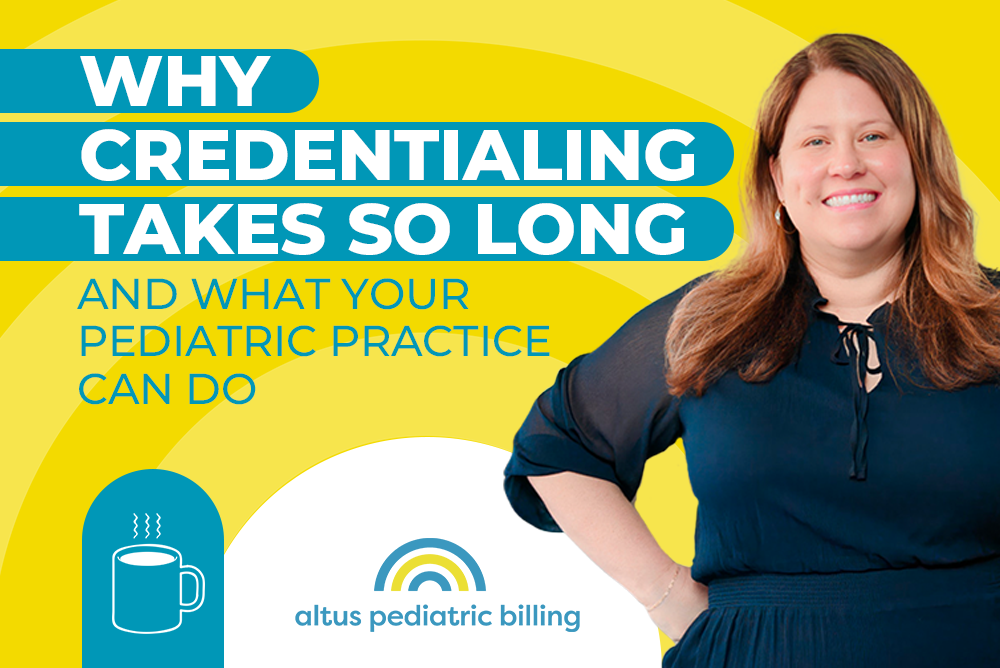Why Credentialing Takes So Long (And What Your Pediatric Practice Can Do)

Let’s talk about something that every pediatric practice eventually faces—and probably dreads: credentialing.
It’s not flashy. It’s not fun. But it’s absolutely vital.
I hear from pediatric practices all the time, and the conversation usually goes something like this:
“I’m so frustrated with our credentialing company. It’s been months, and I’m still getting denials. Why is this taking so long? Does anyone know what they’re doing?!”
Sound familiar?
If you’ve ever felt stuck, ghosted by your payer rep, or like credentialing is a never-ending cycle of forms and faxes—you’re not alone.
Why Credentialing Isn’t as Simple as It Seems
At first glance, credentialing looks easy. Fill out some forms, submit your info, wait for approval. Done, right?
Not even close.
It’s a bit like planning an office lunch. On the surface, it’s straightforward—just order food for 12 people. But then someone’s gluten-free, one person only eats salads, someone else hates pizza (while another only eats pizza), and now you’re juggling dietary needs, budget, and timing.
Credentialing works the same way. Every payer has different rules, different systems, and different contacts. Even once you think you’re done, you’re likely not.
- You fill out the same form over and over.
- One form needs to be faxed. Another notarized.
- Three doctors are listed correctly, but one shows up as a specialist when they shouldn’t.
- Your in-network status is “pending”—for months.
- And your payer rep? Ghosted.
What should be a logical process becomes a time-consuming puzzle. One that’s unfortunately prone to delays, roadblocks, and rejections.
Hug Your Credentialing Specialist (Seriously)
If you’ve got someone handling credentialing for your practice—whether that’s a company or an in-house person—take a moment to appreciate them. Credentialing is far more complex than it looks.
And even though it’s frustrating to see delays, those problems are rarely because your credentialing team is slacking. They’re doing battle with a system that’s messy, outdated, and hard to navigate.
What keeps you getting paid? Being in-network. And that’s what your cred team is working hard to maintain.
3 Ways to Improve the Credentialing Process
Here are a few practical steps to help your team (and your sanity):
1. Follow Up Often—and Through Multiple Channels
A good credentialing specialist doesn’t just submit forms and wait. They:
- Call payer reps directly (even if they don’t answer)
- Use portal systems to check status
- Escalate issues when needed
Credentialing requires persistence. It’s not a “submit once and hope” job—it’s an ongoing follow-up marathon.
2. Track Everything in a Shared Document
Ask your credentialing team to maintain a shared spreadsheet that includes:
- Each provider’s name
- Each payer they’re credentialed with
- The effective in-network date
- Any notes about pending contracts or follow-up status
This gives you visibility into what’s going on without having to chase someone down for updates. It’s also a great way to catch when something slips through the cracks—like a missing contract for one provider.
3. Be Patient (Even When It’s Hard)
Credentialing timelines are rarely short. Some payers take months to process applications, and even then, they may get a detail wrong.
It’s easy to assume delays mean someone’s not doing their job—but most of the time, it’s the system, not the person.
If your credentialing specialist is actively working the accounts every week, following up, and logging progress, trust the process. They’re jumping through a lot of hoops so your practice can stay compliant and get paid.
Bottom Line: It’s Complicated—But It’s Worth It
Credentialing is one of those behind-the-scenes tasks that’s easy to overlook—until something goes wrong. Then it becomes urgent, frustrating, and emotional.
But a good process (and a good partner) makes all the difference.
So, if you’re feeling overwhelmed, take a breath. You’re not doing anything wrong. Credentialing just takes more time, energy, and follow-up than anyone expects.
Thanks for joining me on this Coffee Break. If you’ve got questions or want me to tackle a topic in a future video, just let me know. I’m always here to help.

